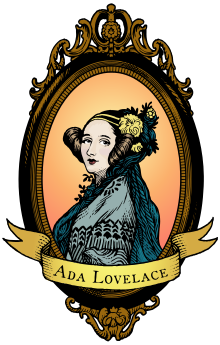
Augusta Ada Byron and now commonly known as Ada Lovelace, was an English mathematician and writer chiefly known for her work on Charles Babbage's early mechanical general-purpose computer, the Analytical Engine. Her notes on the engine include what is recognised as the firstalgorithm intended to be carried out by a machine. Because of this, she is often described as the world's first computer programmer.
Lovelace was born on 10 December 1815 as the only legitimate child of the poet Lord Byron and his wife Anne Isabella Byron. All Byron's other children were born out of wedlock.Byron separated from his wife a month after Ada was born and left England forever four months later, eventually dying of disease in the Greek War of Independence when Ada was eight years old. Ada's mother remained bitter at Lord Byron and promoted Ada's interest in mathematics and logic in an effort to prevent her from developing what she saw as the insanity seen in her father, but Ada remained interested in him despite this (and was, upon her eventual death, buried next to him at her request).
Lovelace developed a strong relationship with her tutor Mary Somerville. She had a strong respect and affection for Somerville.By 1834, Ada was a regular at Court and started attending various events. She danced often and was able to charm many people, and was described by most people as being dainty. However, John Hobhouse, Lord Byron's friend, was the exception and he described her as ".a large, coarse-skinned young woman but with something of my friend's features, particularly the mouth."This description followed their meeting on 24 February 1834 in which Ada made it clear to Hobhouse that she did not like him, probably due to the influence of her mother, which led her to dislike all of her father's friends. This first impression was not to last, and they later became friends.
On 8 July 1835 she married William King, 8th Baron King, becoming Baroness King. Their residence was a large estate at Ockham Park, in Ockham, Surrey, along with another estate on Loch Torridon, and a home in London. They spent their honeymoon at Worthy Manor in Ashley Combe near Porlock Weir, Somerset. The Manor had been built as a hunting lodge in 1799 and was improved by King in preparation for their honeymoon. It later became their summer retreat and was further improved during this time.
They had three children: Byron (born 12 May 1836); Anne Isabella (called Annabella, later Lady Anne Blunt; born 22 September 1837), and Ralph Gordon (born 2 July 1839). Immediately after the birth of Annabella, Lady King experienced "a tedious and suffering illness, which took months to cure."[25] In 1838, her husband became Earl of Lovelace. Thus, she was styled "The Right Honourable the Countess of Lovelace" for most of her married life. In 1843-44, Ada's mother assigned William Benjamin Carpenter to teach Ada's children, and to act as a 'moral' instructor for Ada. He quickly fell for her, and encouraged her to express any frustrated affections, claiming that his marriage meant he'd never act in an "unbecoming" manner. When it became clear that Carpenter was trying to start an affair, Ada cut it off.
In 1883, she met Charles Babbage through Mary Sommerville. He was a Lucasian Professor of Mathematics in Cambridge. This meeting would later on prove to grow into a lifelong friendship, as their mutual interests became the source of their constant correspondence. They would talk about their theories, beliefs, and visions, and she was left fascinated by the work that Babbage did. Charles Babbage was the one who initially called her as the “Enchantress of Numbers”.
Charles Babbage has already gained popularity at that time, and had previously been working on a Difference Engine, a machine that would have the ability to compute for polynomials by using the differences method. Because of a number of personal tragedies and continued disagreements between him and his chief engineer, Joseph Clement, Babbage’s frustrations about the whole project became evident and the government ceased its support for the project in 1842. This paved the way for him to concentrate on a calculating machine, and Analytical Engine.
Although the plans for this project had been drawn in 1834, the government refused to fund it because of the unfinished Difference Engine. However, this project earned interest from abroad. The Italian Mathematician Louis Menebrea discussed the Analytical Engine in a French memoir in 1842. This was where Ada proved to be most useful for Babbage. She was hired to translate the memoir from French to English. Ada worked on the memoir non-stop, working on it within a nine month period from 1842 to 1843. She also added her own notes to the translated memoir, which later on became critical in the work of Alan Turing, Father of Theoretical Computer Science and Artificial Intelligence as he worked on building the first modern computers during the 1940’s. These notes were seen as the first set of algorithms that were to be followed by a machine. They were longer than the memoir itself, and explained in great detail how the Analytical Engine differed from the Difference Engine. And though Babbage and a lot of other people in the same field concentrated merely on a computer’s capacity for calculating and number crunching, Ada believed in the vision that a computer can do so much more than that.
Ada Lovelace died at the early age of 36 in 1852 due to uterine cancer.
No comments:
Post a Comment